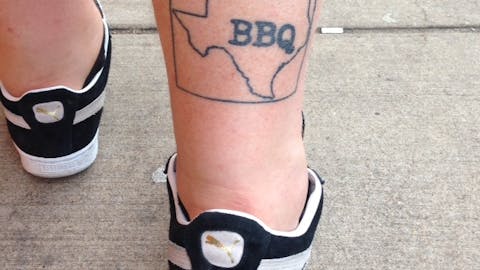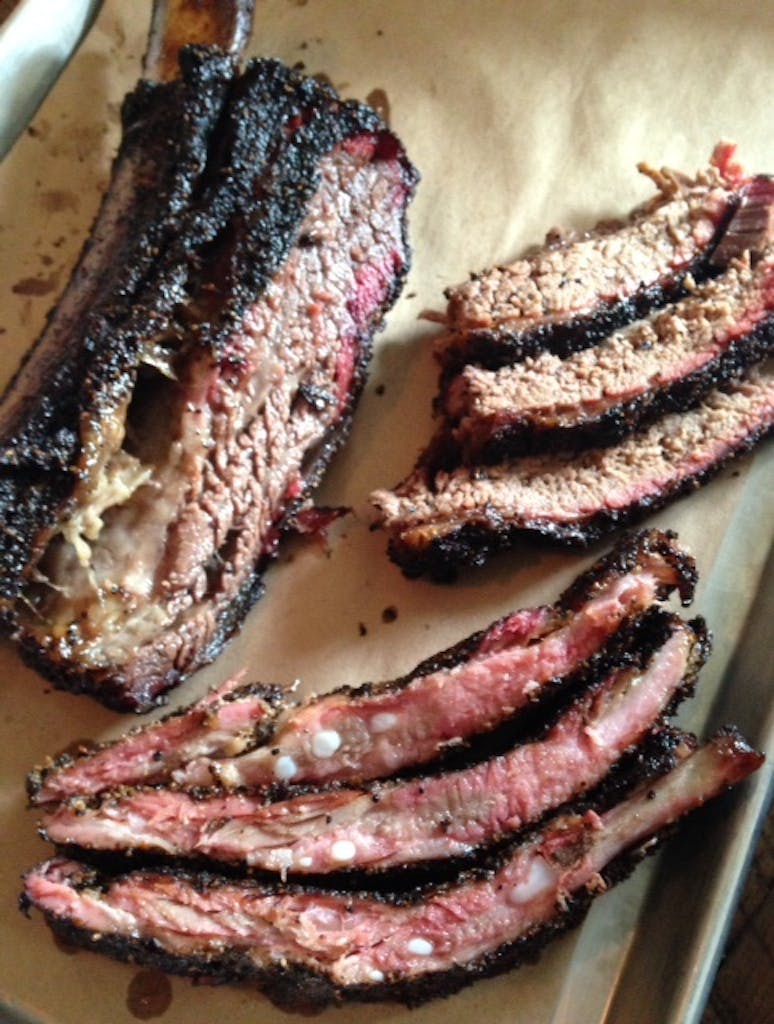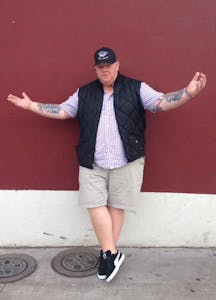 Owner/Pitmaster: Hometown Bar-B-Que; Opened 2013
Owner/Pitmaster: Hometown Bar-B-Que; Opened 2013
Age: 42
Smoker: Indirect Heat Wood-Fired Pit
Wood: Oak and Cherry
Billy Durney is all New York, but he knows where to go in Texas to find great barbecue. This past week his restaurant Hometown Bar-B-Que in Red Hook, Brooklyn celebrated its one year anniversary. Afterwards, he celebrated with a trip to Austin and Dallas for some pro-style barbecue eating.
I enjoyed a great meal at Hometown when I visited there earlier this year. It was this place (along with Delaney Barbecue) that I had in mind when I told the New York Times “The brisket I’ve had in New York lately is better than a lot of places in Texas.” That’s what happens when you learn from one of the best – Wayne Mueller – and the beef short rib and smoked brisket at Hometown even make Mueller proud.
While in Dallas, Durney and I ate together at Pecan Lodge, Slow Bone, and Lockhart Smokehouse. Along the way it was clear he was a good judge of barbecue, and that he is obsessed with smoked turkey. We sat down to talk at Lockhart Smokehouse over an order of brisket and prime rib.
Daniel Vaughn: You came into Austin this weekend to attend the Texas Monthly Barbecue Festival, but you’ve also been visiting a number of barbecue joints in the state while you’re here. Where all have you eaten?
Billy Durney: The first day we went to La Barbecue. We had a great meal there. They were very hospitable. From there we went to Micklethwait. It was pouring rain so it was hard to enjoy the meal there.
DV: Austin is all about the outdoor barbecue experience.
BD: It’s kinda cool, but it would be too much for me to deal with personally. There’s the heat and the rain and the bugs, but the truth is it’s all that air hitting the meat. What I found was a beautiful plate of meat coming out of a window, but by the time you get a drink and get to your table it’s gray and dry if there’s any sort of breeze. This is a science. Air is barbecue’s best friend until you put a knife through it. Then it’s kryptonite.
DV: Anywhere else?
BD: We went to Freedmen’s. I didn’t know what to expect. There was a smoker in the back and the whole top rack was full of beets. I thought that was so interesting. I didn’t get to eat them because they were cooking, but I’ll make a special trip back to Austin to try that side dish. We ordered the whole menu. The ribs were delicious. The brisket had one of the best barks on it that I’ve had in a long time. It was all just perfectly executed.
DV: I saw you were at Louie Mueller in Taylor yesterday.
BD: Yes. We stopped at John Mueller Meat Company in the morning before going out to Taylor. Louie Mueller is what I consider the mecca of barbecue in Texas. Wayne Mueller is like a brother. I also went to Taylor Café for the first time, and I had a wonderful experience. They knew right away I wasn’t from around there with my suede Pumas and my fancy watch, but they loved my tattoo.
DV: Did you meet Vencil?
BD: He told me he actually spent some time in Red Hook. When he was in the Navy he remembered passing by in a ship and seeing the Statue of Liberty, which is what I look at every morning when I’m cooking out by Valentino Pier. It’s the closest frontal view of the Statue of Liberty from land.

DV: So you don’t cook in the restaurant?
BD: No. We have our smokers about three blocks away. It’s a very industrial area. We have some smokers in shipping containers. It’s a special place to cook barbecue.
DV: What kind of smoker are you using?
BD: We use four Lang 108 reverse-flow smokers. We also have a new custom made one that was for a job we did with Mayor Bloomberg at Randall’s Island in New York. Lang sent it up. We made some modifications so we could easily fit a whole hog in it without removing shelving.
DV: Are there challenges with cooking in a reverse-flow smoker?
BD: We’re looking at delving into an indirect cooker soon. Right now I have to manipulate the food a lot inside the smoker. We have three hotspots in the cooker. There’s one right there at the firebox, then another in the upper left and one in the upper right portion where the smoke exits into the stack.
DV: Have you cooked on a standard offset?
BD: I have not, other than a very small one where everything is hot in there. I actually massacred the first piece of meat I tried to cook in an offset smoker.
DV: Hometown Bar-B-Que just celebrated its one year anniversary (opened 09/12/13). How long before that were you cooking barbecue?
BD: I threw my hat in the ring about six or seven years ago. I had a job that was really stressful, and I’d come home from traveling, sit in the backyard, light a cigar, and drink a bourbon. I had a little 18.5” Weber Smokey Mountain bullet smoker. We cooked chicken and ribs before I got really crazy and started trying to cook pork belly, brisket, and pork shoulder.
DV: Do you remember how that first brisket turned out?
BD: I remember exactly how it turned out. It was like shoe leather, jerky, and a hardwood table all rolled into one.
DV: What did your family say?
BD: My wife spit it out.
DV: I thought friends and family were obligated to say it’s good.
BD: Nah, we have an honest family that keeps you in check. But it wasn’t too long after that when I cooked one of the best things I can remember cooking. It was about three weeks later. I had started cooking something like three or four times a week. I went to a local butcher called Paisano’s and I got these long beef back ribs. I cooked three perfect racks with a beautiful clean smoke through the whole thing. There was this great smoke ring and the fat was so well rendered. My wife and I cut into them and we were like “Holy s***, I actually did it! Look at that pink ring. It’s glistening!” I knew right there that I could do this. I didn’t know I could do it for four thousand people a week, but I knew I could cook it.
DV: That moment of cutting into the beef ribs is something a lot of amateur cooks have, but when you’re cooking for a restaurant you don’t have the luxury of cutting into something to see if it’s cooked well. You need to do it by feel and touch. How did you get to that point?
BD: Shortly after that I bought a second one that was larger. I started to learn how to cook multiple meats. Then I bought a Lang.
DV: Who were you cooking for then?
BD: Family and friends and a local bar. We would cook and drive it over to the bar. We did that for a full year, and we just gave it away.
DV: You were giving it away?
BD: I didn’t sell anything until our first catering gig which was about six months before we opened the restaurant. That was over a hundred people. I only did three cooks of that size before opening the restaurant. On opening day of the restaurant we served eight hundred people.
DV: That’s some good business for the first day. How did you get word out so quickly?
BD: We got some local press, but we also had a lot of traction from Sandy. When Hurricane Sandy (10/29/12) hit we lost everything except the one smoker. We were five months into the first build out and it wiped us out. All of our restaurant equipment was gone. We would have been open a few months later if Sandy hadn’t happened.
DV: Red Hook was hit particularly hard by the storm, correct?
BD: Yes. Red Hook was right in the focus of the storm. We took over six feet of water. Our neighbors took ten.
DV: What did you do?
BD: I had the smoker professionally cleaned, then I sat out there for sixteen days cooking for the community. They didn’t have electricity or food or anything. We got four thousand pounds of meat donated. We went to Yeti who got us some coolers. We went and bought a refrigerator because we needed somewhere to store the donated meat. We cooked a lot of ribs. I’d walk into the local church, and they’d say “Hey, there’s the rib guy.” Then we started getting smart and cooking briskets and pork shoulders so we could feed more people.
DV: That had to help sharpen your barbecue skills.
BD: Honest to God, my full training for the restaurant were those two and half weeks where I was cooking for the masses three times a day. That’s when I learned the internal organs of the smoker. We were churning and not burning.
DV: The community must have been very grateful.
BD: As grateful as the community was for what we did, I was getting more out of it. I was a nervous wreck. I’d given up a very successful career to make barbecue for a living. Thanks to my wife having a belief in me, I rolled the dice on a crazy business where ninety percent of people fail. I was afraid. My relaxation, my Xanax, was to sit out there and cook. The community and I became one, and I became one with that smoker. By the time we were about to open I had another nine months on the smoker. Then I knew how to make great barbecue. We opened the restaurant with an Old Hickory that we cooked ribs and chicken on, and the bigger cuts went on the Lang. We had one Lang 84, and now we’re cooking on four 108’s twelve months later.
DV: Do you remember how many briskets you cooked on that first day?
BD: I do. We cooked twelve and there were two left. We cooked sixty this past Saturday.
DV: It sounds like cooking for the community helped you sharpen your craft, but it probably got you some customers for life.
BD: No doubt about it. As I was feeding them, they were comforting me. When we announced we were opening, it was a big deal for the neighborhood. They all thought after Sandy that we were going to leave. I very quickly stated publicly that if I wasn’t doing it in Red Hook, I wasn’t doing it at all.
DV: Can you describe Red Hook?
BD: Red Hook is my heart and soul. I grew up not far from there. It’s also a seaside community, a tiny village with such an interesting group of people. We have painters and sculptors, two distilleries and two breweries.
DV: Compared to the rest of New York, it’s not an easy place to get to. It remains a bit secluded, right?
BD: Yeah. Brooklyn is massive. We’re actually just a couple miles from downtown Manhattan. Now we’ve been blessed with a ferry that gets you here from Wall Street in twenty minutes. It’s a game changer for the community, but there are no trains. If you take a train it will drop you off a mile from Hometown.
DV: Let’s get back to the cooking. In that quality time that you spent with your smoker, what did you learn about cooking barbecue?
BD: To me it’s not about what’s happening inside the smoker. It’s about what’s going on with the fire. It’s about that, and we’ve become experts at holding the meat. It’s something that I think a lot of people forget that massive step.
DV: Yes. You’re open all day, so there’s a chance that you’ll be holding something longer than it was on the smoker.
BD: Just about. All of our briskets come off before 1:00pm on weekdays. For the rest of the time you have to be really smart about how you hold that beef. I’m proud of how we do it. It’s crucial.
DV: Is this a holding method you developed on your own?
BD: I spent a day in Taylor at Louie Mueller. It’s the reason I wrap better than I was doing. We rest our briskets for thirty minutes, then wrap in food film, then hold them. The key is to take the food film off, re-rest them, then carve to order. For me, that’s how I make the best brisket that I can make.
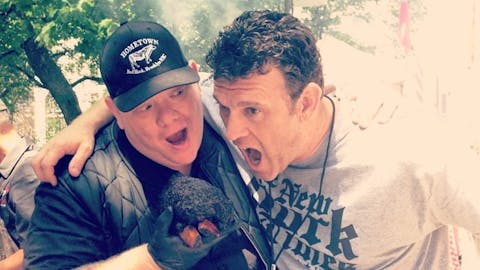
DV: How did you meet Wayne?
BD: I went out to Murphysboro, Illinois to a class on whole hog. There were a bunch of heavyweight pitmasters who were going to be there. The first day I met Wayne I told him about my first visit to Louie Mueller. My first step into it, I was devastated. I knew that was the model that I had to strive for. We became instant friends. We’re really close. We were locked into the way we cook. All those men taught me something. It might not have been about cooking, but about being a good barbecue person. There’s no better ambassador in the world than Mike Mills. Then there’s Sam Jones and Rodney Scott who are gifted and generous. Then Wayne who is a smart and aggressive businessman with something to prove. He has revived Louie Mueller.
DV: When I visited Hometown and had that beef rib, all I could think about was Louie Mueller. I’m guessing that was on purpose.
BD: Yes. If I’m going to cook the best beef rib I can cook, then it will have a concept similar to where I ate the best beef rib of my life. Certainly to this point, Louie Mueller’s is the best beef rib that I’ve eaten.
DV: You’re brisket also tastes like Texas-style barbecue.
BD: I won’t lie. My favorite barbecue comes out of the state of Texas, and my favorite two places to eat it are at Franklin and Louie Mueller. There is other great barbecue that I’ve eaten here, but those two places are the most special places in the state. If my barbecue emulates theirs in any way shape or form then I’m proud of that. I’m definitely not trying to copy them, but I’m trying to pay homage.
DV: The rest of your menu has a lot more variation in it.
BD: I’m from New York, and I’m proud of the communities that I’ve lived in and the flavor profiles that come out of them. Whether that’s our Caribbean jerk baby back ribs or the lamb belly banh mi. We’re working on a Korean sticky rib that we launched on our one year anniversary. I’m working on a Cantonese bao. All of these are using Southern techniques of smoking, then I’m manipulating the flavors after they come off the smoker.

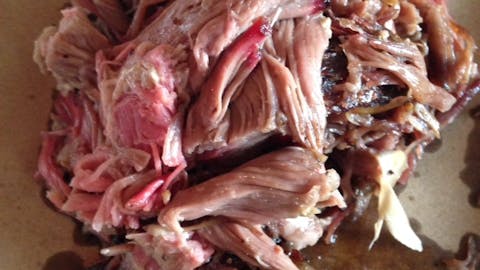
DV: Is part of your goal to try and create a barbecue style that is of New York instead of just replicating other traditional styles?
BD: I love cooking with wood, and I love manipulating flavors. I’m just trying to cook the best bite I can cook. I don’t know what to call it. We’re doing it in Brooklyn, and I’m very proud to be part of that community.
DV: Have you thought about the freedom you have to experiment because there aren’t those same traditions and expectations in New York that you might have in Texas?
BD: I say it all the time. They would hang Sam Jones up in a tree in North Carolina if he were to make a jerk baby back rib. Poor Wayne Mueller in Taylor got crap for putting pork sliders on the menu. The beauty of cooking barbecue in New York is that we don’t have any of our grandfather’s stipulations of what we can and cannot do. I’m doing whole hogs Cuban style in a Caja China. If I could get my hands on a small goat, I’d do that too.
DV: You spoke about your previous job, but what was it?
BD: I was a partner in a private protection firm. We gave security service to private citizens including A-list celebrities. I’m blessed to have spent a career doing something I love, but I was away from my daughter too much travelling internationally two months out of the year. Now she gets to be a part of the restaurant. She knows every job in the restaurant. I got to travel the world. Some of my close friends are still handling security details with the secret service.
DV: Did you make the right decision?
BD: I couldn’t be happier with the choice I made. A lot of that came with my wife Lianna allowing me to give up a very successful career and chase my dream – to cook barbecue.


